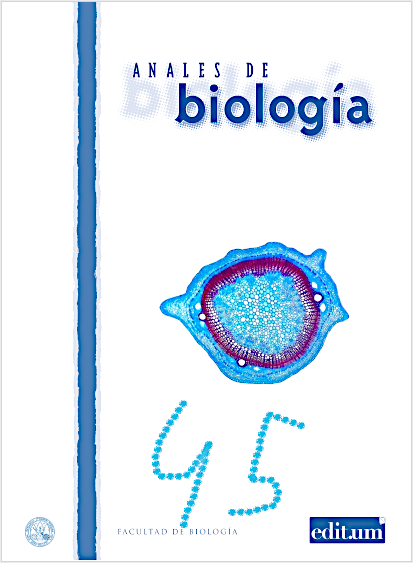Anatomical and histochemical study of the stem and leaves of Jasminum azoricum L.
Abstract
The present study aimed to characterize the anatomy and histochemistry of the stem and leaves of Jasminum azoricum L. Thus, semi-permanent slides were prepared containing transverse sections of the stem and leaf, in addition to paradermal sections of the leaf blade, analyzed by optical microscopy. Histochemical tests were also carried out in order to verify the site of accumulation of chemical constituents in cross-sections of the leaf blade. The anatomical characterizations allowed the identification of important characteristics to distinguish the species and the histochemistry revealed the sites of synthesis and/or storage of the metabolites. The results found help to identify the species studied and point out possible metabolites that have considerable medicinal properties.
Downloads
-
Abstract316
-
PDF ENG225
References
Akhtar N, Hafiz IA, Hayat MQ, Potter D, Abbasi NA, Habib U, Hussain A, Hafeez H, Bashir MA & Malik SI. 2021. ISSR-based genetic diversity assessment of genus Jasminum L. (Oleaceae) from Pakistan. plants 10: 1270. https://doi.org/10.3390/plants10071270
Ali FAMA. 2019. A comparative pharmacognostical study of certain Jasminum species. PhD Thesis, Cairo University, Cairo.
Ali JK & Sosa AA. 2016. An anatomical study of some characters in certain species of genus Jasminum L. growing in Iraq. International Journal of Science and Research 5(10): 1137-1140.
Balkrishna A, Rohela A, Kumar A, Kumar A, Arya V, Thakur P, . . . & Kuca K. 2021. Mechanistic insight into antimicrobial and antioxidant potential of Jasminum species: a herbal approach to disease management. Plants 10: 1089. https://doi.org/10.3390/plants10061089
Cordeiro SZ. 2020. Jasminum azoricum L. Herbário da Universidade Federal do Estado do Rio de Janeiro. Brazil. available at http://www.unirio.br/ccbs/ibio/ herbariohuni/jasminum-azoricum-l (accessed on 15-II-2022)
Deng Y, Li C, Shao Q, Ye X & She J. 2012. Differential responses of double petal and multi petal jasmine to shading: II. Morphology, anatomy and physiology. Scientia Horticulturae 144: 19-28.
El-Hawary SS, El-Hefnawy HM, El-Raey MA, Mokhtar FA & Osman SM. 2020. Jasminum azoricum L. leaves: HPLC-PDA/MS/MS profiling and in-vitro cytotoxicity supported by molecular docking. Natural Product Research 35: 5518-5520. https://doi.org/10.1080/14786419.2020.1791111
El-Sayyad SM, Ross SA & El-Keltawi NA. 1983. A comparative macro- and micromorphological study of the stems and leaves of certain Jasminum species cultivated in Egypt. Bulletin of Pharmaceutical Sciences, Assiut University 6: 154-171. https://doi.org/10.21608/bfsa.1983.100952
Gonzalez AM & Solís SM. 2016. Domacios y anatomía foliar de Jasminum cultivados. Lilloa 53: 1-9.
Green PS. 1969. Studies in the genus Jasminum L.: IV: The so-called New World species. Kew Bulletin 23: 273-275.
Hari N & Nair VP. 2018. Preliminary phytochemical evaluation and HPTLC fingerprint profile of Jasminum azoricum L. International Journal of Scientific Research in Science, Engineering and Technology 4: 791-795.
Jensen W. 1962. Botanical histochemistry: principles and practice. San Francisco: W. H. Freeman, p. 408.
Johansen DA. 1940. Plant microtechnique. New York: McGraw-Hill.
Krauter D. 1985. Erfahrungen mit Etzolds FSA-Färbung für pflanzenschnitte. Mikrokosmos 74: 231-233.
Kumar ESS & Sabeena A. 2013. Taxonomic notes on two Jasminum species (Oleaceae) from India. Taprobanica 5: 114-147. http://dx.doi.org/10.4038/tapro.v5i2.6291
Mace ME, Bell AA & Stipanovich RD. 1974. Histochemistry and isolation of gossypol and related terpenoids in roots of cotton seedlings. Phytopathology 64: 1297-1302.
Mace ME & Howell CR. 1974 .Histochemistry and identification of condensed tannin precursor in roots os cotton seedlings. Canadian Journal of Botany 52: 2423-2426. https://doi.org/10.1139/b74-314
Metcalfe CR & Chalk I. 1950. Anatomy of the Dico-tyledons l. Clarendon Press, Oxford. Inglaterra.
Rastogi RP, Mehrotra BN, Sinha S, Pant P & Seth R. 2001. Compendium of Indian medicinal plants. Lucknow: Central Drug Research Institute.
Sampaio D. 2020. Oleaceae in Flora e Funga do Brasil. Jardim Botânico do Rio de Janeiro. Available at https://floradobrasil.jbrj.gov.br/fb104463. Accessed on 13-V-2022.
Sass JE. 1951. Botanical Microtechnique. Ames: The Iowa State College Press.
Thiruvengadam S, Nivedha S, Pujita V & Romauld SI. 2018. Detection of antioxidant and antimicrobial activity of leaf extract of Jasminum azoricum. Research Journal of Pharmacy and Technology 11: 3629-3632. https://doi.org/10.5958/0974-360x.2018. 00668.6
Yoder LR & Mahlberg PG. 1976. Reactions of alkaloid and histochemical indicatorsin laticifers and specialized parenchyma cells of Catharantus roseus (Apocynaceae). American Journal of Botany 63: 1167-1173. https://doi.org/10.1002/j.1537-2197.1976.tb13 202.x
Copyright (c) 2023 Anales de Biología

This work is licensed under a Creative Commons Attribution-NonCommercial-NoDerivatives 4.0 International License.
Las obras que se publican en esta revista están sujetas a los siguientes términos:
1. El Servicio de Publicaciones de la Universidad de Murcia (la editorial) conserva los derechos patrimoniales (copyright) de las obras publicadas, y favorece y permite la reutilización de las mismas bajo la licencia de uso indicada en el punto 2.
2. Las obras se publican en la edición electrónica de la revista bajo una licencia Creative Commons Reconocimiento-NoComercial-SinObraDerivada 3.0 España (texto legal). Se pueden copiar, usar, difundir, transmitir y exponer públicamente, siempre que: i) se cite la autoría y la fuente original de su publicación (revista, editorial y URL de la obra); ii) no se usen para fines comerciales; iii) se mencione la existencia y especificaciones de esta licencia de uso.
3. Condiciones de auto-archivo. Se permite y se anima a los autores a difundir electrónicamente las versiones pre-print (versión antes de ser evaluada) y/o post-print (versión evaluada y aceptada para su publicación) de sus obras antes de su publicación, ya que favorece su circulación y difusión más temprana y con ello un posible aumento en su citación y alcance entre la comunidad académica. Color RoMEO: verde.











